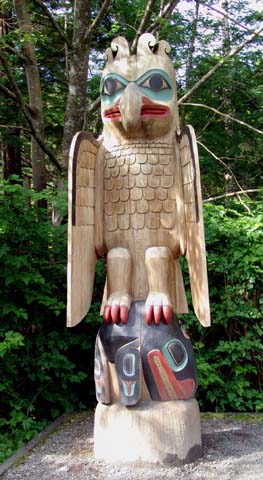
Ketchikan to Wrangell
June 13-15, 2004
Totem Bight State Park, just north of Ketchikan, has an interesting collection of totem poles with very nice interpretive information. When we stopped there, the place was swamped by bus loads of cruise ship passengers. This made photography difficult, so we eavesdropped on the descriptions given by their tour guides and then came back later to take pictures.
The poles at Totem Bight were carved during the 1930s and 1940s
by native carvers employed by the CCC. They are copies of original poles at
abandoned Tlingit and Haida villages. The CCC helped to preserve the Native
American culture of the area by hiring skilled Native American carvers; this had
two effects: younger carvers were trained by the older carvers, and totems which
had been left to rot in the woods were either repaired or duplicated.

This totem pole shows the thunderbird on top of a killer whale. The
thunderbird is a mythical bird that that creates thunder by beating its wings
and lightening by blinking its eyes. It lives on the mountaintops and devours
killer whales.
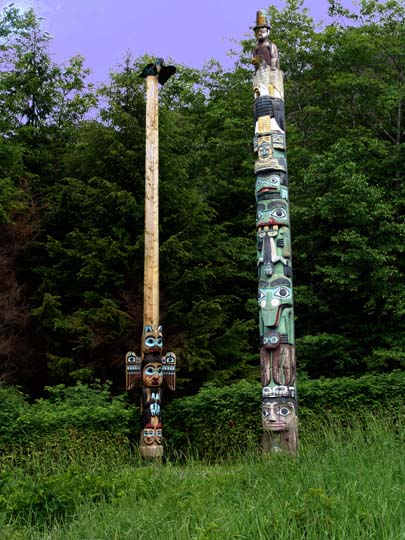
The totem pole on the left is of Tlingit origin, while the one on the right
is of Haida origin; notice the rather different styles. The Tlingit pole shows
the Kadjuk bird at the top. Below the plain portion of the pole is Raven, with
his breast forming the headdress of his wife, Fog Woman. Fog Woman is holding
two salmon. The two faces below Fog Woman represent the two slaves of Raven. The
Haida pole shows a village watchman at the top. Below are two eagles. The
duck-like beaked creature is the mythical sea monster; the small face under the
beak represents the monster's spirit power. The tentacles represent a devilfish
in the act of devouring the human being at the base of the pole.
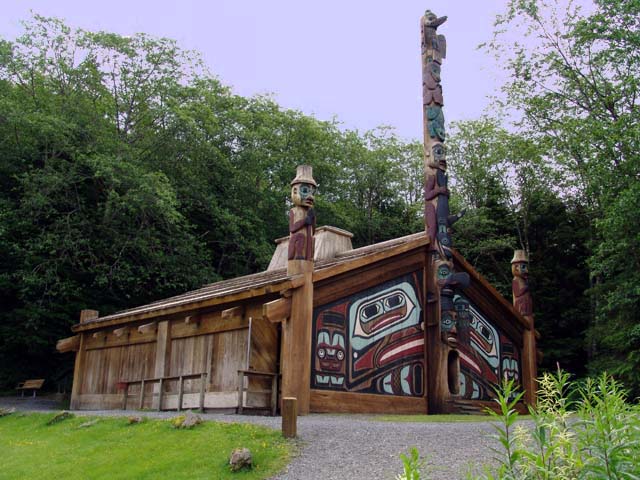
This clan, or community house, typically housed several families of one clan.
Families belonged to clans, based on the clan of the mother. This clan house was
built by the CCC, but is typical of clan houses in the native villages. The
corner poles have a village watchman at the top. The opening at the base of the
central totem pole was the entrance. It was normally very small as a defensive
measure, but this one was enlarged to accommodate tourists.
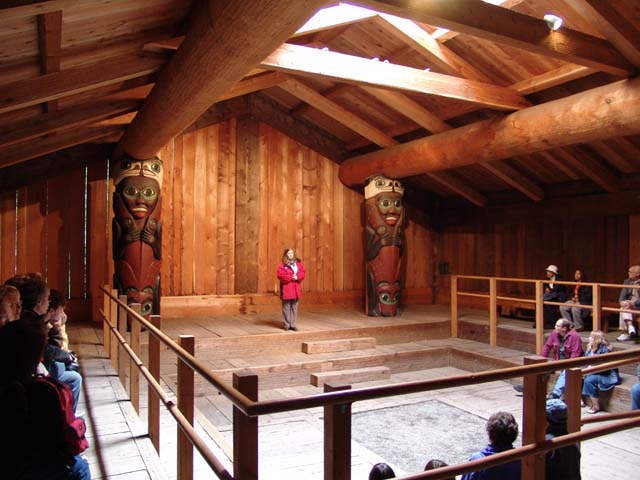
The interior of the clan house. (A tour guide is explaining life in the clan
house to a group of cruise ship passengers.) The clan house was composed of one
large room; each family was allotted their living space, but shared a
common fire in the center. The number of levels in the house was a measure of
the wealth of the clan.
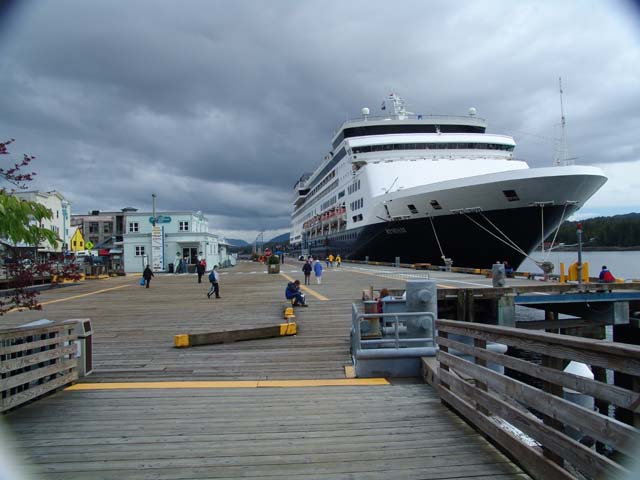
A cruise ship docked in Ketchikan; the ships are huge.
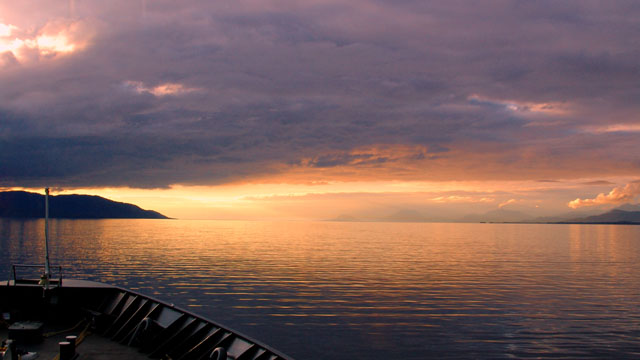
On our ferry heading for Wrangell. The ferries represent an interesting
scheduling problem, if you are mathematically inclined. I am used to thinking of
ferries as going from point A to point B and then returning to point A; everyone
gets on at point A and gets off at point B, and a new load of passengers get on
at point B and get off at point A. Things are not so simple for the Alaskan
ferries. This ferry was going to six ports before turning around. Hence there
are vehicles onboard going to each destination. How do you load a ferry so that
the vehicles getting off at one destination can do so without requiring the
vehicles going on to a later destination be unloaded and then reloaded? In this
case, some of the people with trailers had to back down the ramp and turn 90
degrees into the aisle, so they were in the right location, and pointed in the
right direction, to get off at their stop. Since our destination, Wrangell, was
the first stop, we were the among the last to load. We could drive in normally,
but had to back up and turn around inside the ferry to unload.
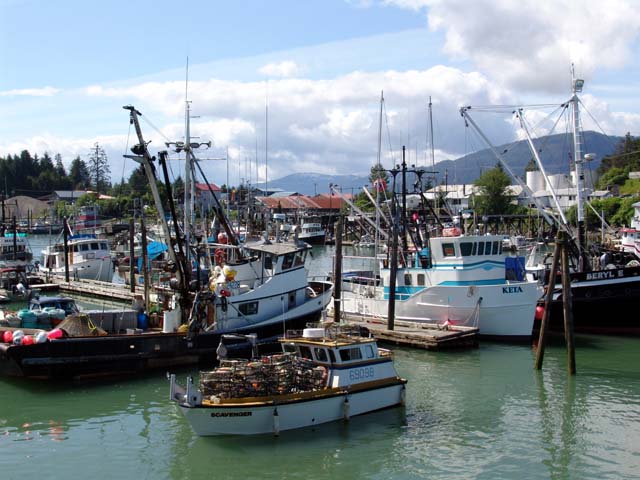
The Wrangell harbor. Wrangell is much smaller than Ketchikan, and much less
touristy. The main economic activities appear to be commercial fishing and
lumbering. The boat in the foreground has a stack of crab traps on board.
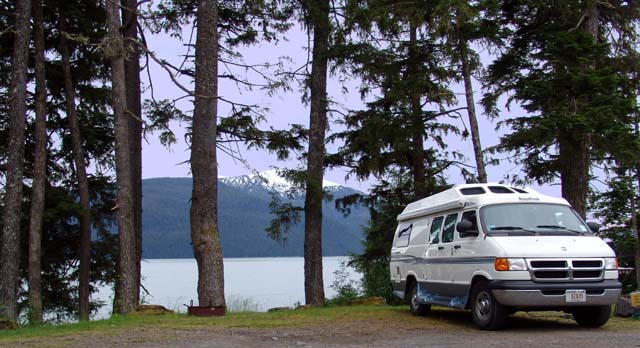
Our campsite in Wrangell. It was right on the shore. Although there were 16
campsites, it had only a few other campers. Very nice for $10 per night,
with electrical hookup.

Sunset from near our campsite.